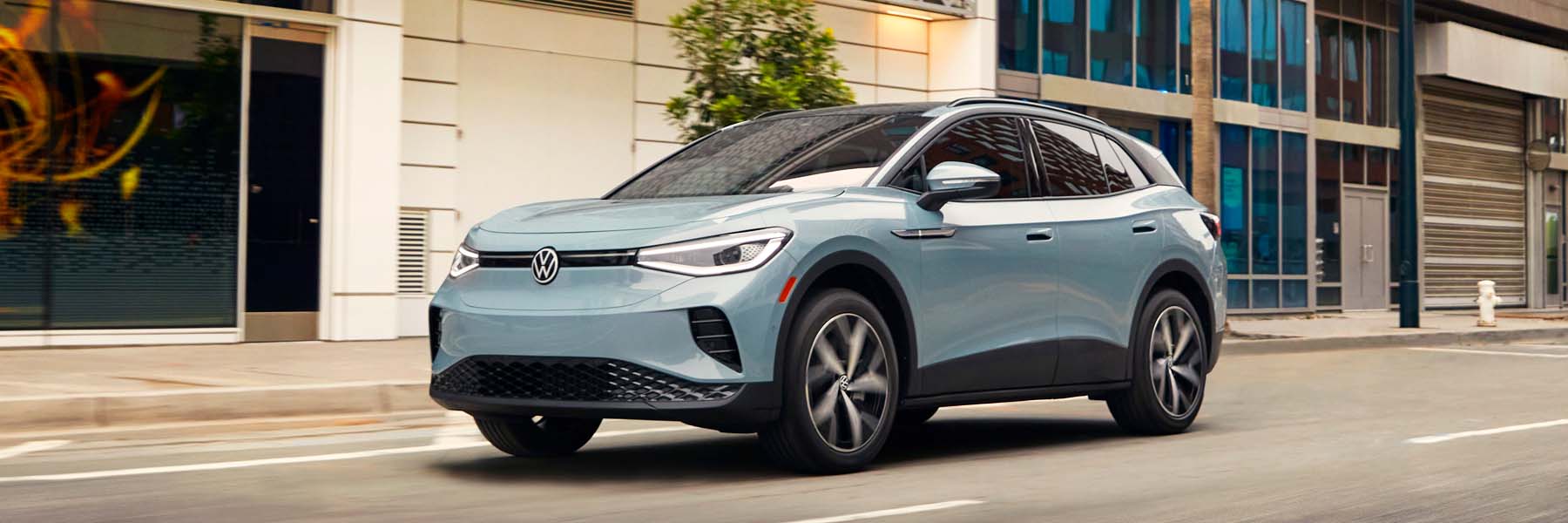
What you need to know about making the switch to electric.
Going electric isn’t a sacrifice anymore. From the styling of the vehicles themselves to charging access options, it’s an exciting moment for mobility. And the future of electric vehicles is here with the Volkswagen ID.4 electric vehicle. Learn more about the latest EV technology, the near-instant torque and acceleration, cost savings, charging options and more. You have questions about moving to electric mobility. We have the answers.
Intro to Electric Vehicles
Say goodbye to range anxiety, and hello to the open road.
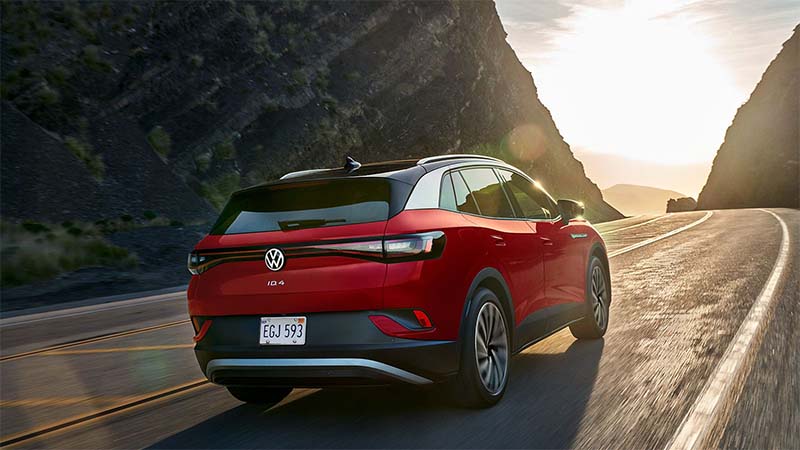
How far can an electric vehicle go on a full charge?
If you’ve been researching electric vehicles, you may have heard the term “range anxiety.” Sounds a little scary, doesn’t it? It refers to the worry of driving an electric vehicle with a low battery percentage, and not being able to find an available charger before the battery runs out.
Well, fear not: America’s public charging infrastructure is extensive and growing rapidly. Here’s what to know about EV driving range.
Modern EVs offer plenty of range.
Today’s EVs give you the freedom to roam with confidence. The 2024 Volkswagen ID.4 Pro electric SUV offers an EPA-estimated driving range of 291 miles.1
What can impact range, and how do you gauge what’s available?
Range estimates can be lower in winter or higher in summer due to the effect of weather on batteries; other factors like your driving habits can affect the range estimate as well.2 But, good news, your EV will help keep you informed about available range. All you have to do is check the range estimate in your head-up display.
You’ll find more and more public chargers on the road.
America’s roadgoing experience is rapidly transforming to accommodate EV charging. One of the leaders in this shift is Electrify America, a convenient and reliable network of DC fast-charging stations. Electrify America currently has more than 875 stations and over 3,800 DC fast chargers along major highways and cross-country routes to help keep you charged on road trips. The 2024 Volkswagen ID.4 SUV includes a 3 year Electrify America Pass+ membership with Plug&Charge and 500 kWh of charging included. Pass+ members save about 25% compared to the Electrify America Guest and Pass member base charging rate.3
You’ll have coverage for the unexpected.
If you own an ID.4 and find yourself running out of battery power while on the road, know that you’ve got Volkswagen Carefree Coverage4 at no additional cost. It includes VW Roadside Assistance5 available 24 hours a day, 7 days a week.
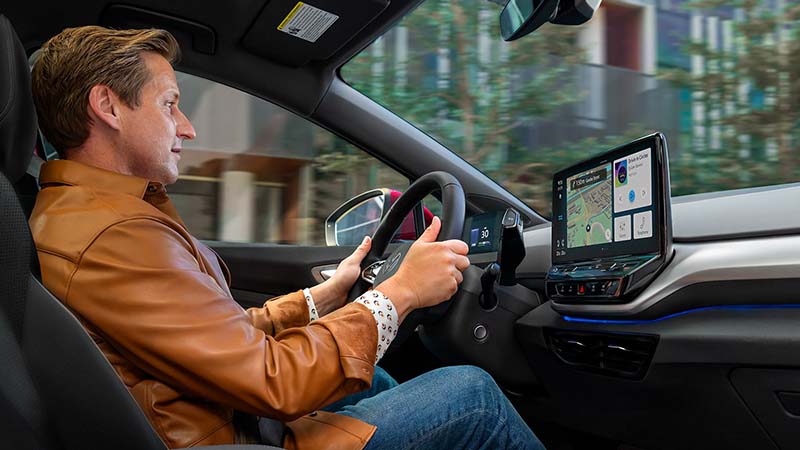
Why switch to an electric vehicle?
It’s an exciting time to be considering an electric vehicle, as new EV models from Volkswagen and other automakers hit the market with a level of style, comfort and practicality that was once solely the domain of gas-powered vehicles. Meanwhile, the American roadgoing experience is transforming itself to accommodate this new world of EVs. Here are four reasons why you’ll want to switch to an electric vehicle today.
An EV produces zero direct emissions from driving.
Electric vehicles generate no direct tailpipe emissions, which means that choosing an EV over a conventional gas-powered vehicle can help reduce carbon dioxide emissions.
At-home charging can be faster than you might think.
While most EVs allow you to plug into a standard 120V outlet, for much faster charging you’ll want to get a professionally installed Level 2 (240V) charging unit like the HomeStation Level 2 Home Charger with app control from Electrify Home. The ID.4 takes around 7.5 to 11.5 hours to recharge at a Level 2 charger.6
Charging at home can be cheaper than filling a gas tank.
The 2024 ID.4 can provide an estimated $6,000 in fuel cost savings over 5 years compared to the average gasoline vehicle.7
And by the way, an EV can be really fun to drive.
Saving money is great, but that doesn’t mean you have to sacrifice fun when driving. An EV’s electric motor delivers power to the wheels instantaneously, so there’s no need to rev it to get up to speed. You’ll experience maximum torque beginning at 0 RPM—which translates to smooth, seamless acceleration, and quite possibly a big grin on your face.
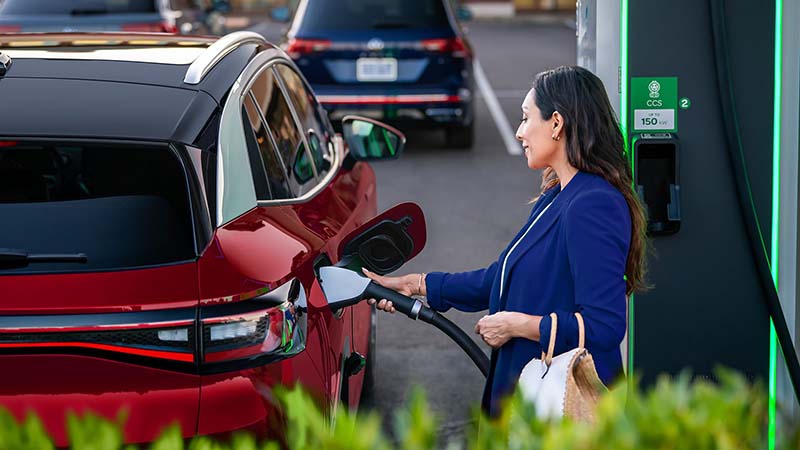
How do electric vehicle batteries work?
The battery system in an electric vehicle may be a distant cousin to the one in your smartphone, but it packs a lot more power and serves a very different purpose. If you’re wondering just what EV batteries do and how they do it, these key facts can help.
Think of the power of your smartphone battery, multiplied by thousands.
EV batteries drive the motor; the motor drives the wheels.
Electric vehicles carry a large battery pack (made of lithium-ion batteries, in most cases) that sends power to an onboard electric motor. The motor then drives the vehicle’s wheels to get you down the road. Separately, there’s an auxiliary battery that delivers power for vehicle accessories like heating and air conditioning.
EV batteries get charged in the same way as your phone, kind of.
You charge an EV by plugging the vehicle into a charging unit. Except this charger isn’t like that smartphone power cord, the one you can never seem to find when you need it. EV charging is often done either through a professionally installed home system like a Level 2 wall box or a public charger like a Level 3 DC fast charger. EVs can also be charged by using a standard U.S. electrical outlet, though charging through this method is significantly slower than using a Level 2 or Level 3 charger.
EV batteries work like every other battery cell.
Time to put on your physics hat, just for a minute. Each EV battery has two electrodes—the cathode (positive) and the anode (negative)—and a chemical substance between them called an electrolyte. When connected to an electric circuit, electrons travel from the anode to the cathode via the electrolyte. Ions, meanwhile, flow in the opposite direction, which creates an electric current. Physics lesson completed.
An EV converts AC to DC.
When you charge an EV from a standard U.S. electrical outlet, the electricity is delivered as alternating current (AC). EV batteries, however, operate on direct current (DC). Electricity from the outlet has to be converted to DC; this happens through the vehicle’s onboard converter. How long it takes to charge an EV is dictated by the fact that the converter can handle a certain amount of current at a time.
EV batteries store a lot of energy.
The battery pack in the Volkswagen ID.4 electric SUV holds 82 kilowatt-hours of energy. Given that the average U.S. home uses around 30.5 kilowatt-hours of energy a day, according to federal energy data, the amount of energy in an ID.4 battery pack is enough to power a home for about two-and-a-half days. To put it a different way: Imagine the power of a typical smartphone multiplied by 5,500.
EV batteries get re-energized when you brake.
In an EV, braking actually restores energy to the battery. When you use the brake, or even take your foot off the accelerator, the vehicle stores excess energy for later use. It’s called regenerative braking, and it works by reversing the flow of energy: The vehicle’s slowing wheels turn the electric motor, which channels energy back to the battery.
An EV tells you when the batteries are low on power.
Just like a conventional gas-powered vehicle, an EV will warn you when it’s running low on power. The ID.4 has an onboard Battery Management System (BMS) that automatically helps protect the battery when it starts to run low, by switching to energy-saving mode.
An EV can start in cold weather with no problem.
Gas-powered vehicles aren’t the only ones designed to start easily in the cold. Technology in the ID.4 helps optimize heating efficiency while reducing the impact of cold temperatures on the vehicle. In other words, the vehicle prepares for those chilly winter mornings, just like you do with your first cup of coffee.
An EV battery pack is designed to last for many years.
EV batteries are built to provide usable power over many years of vehicle ownership. While a battery’s charging capacity can diminish over time, the battery in the ID.4 uses smart strategies like liquid cooling, energy reserves and other processes to help preserve battery life.
Inside the ID.4
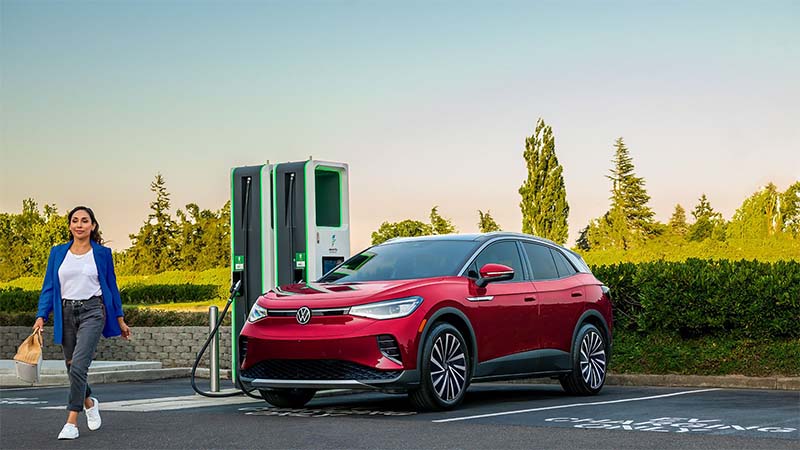
The future of electric is here.
The Volkswagen ID.4 EV is truly something to behold. With a striking, aerodynamic road presence and a spacious, comfortable interior, it'll transform how you think about electric cars.
> Shop ID.4
> Learn More About ID.4
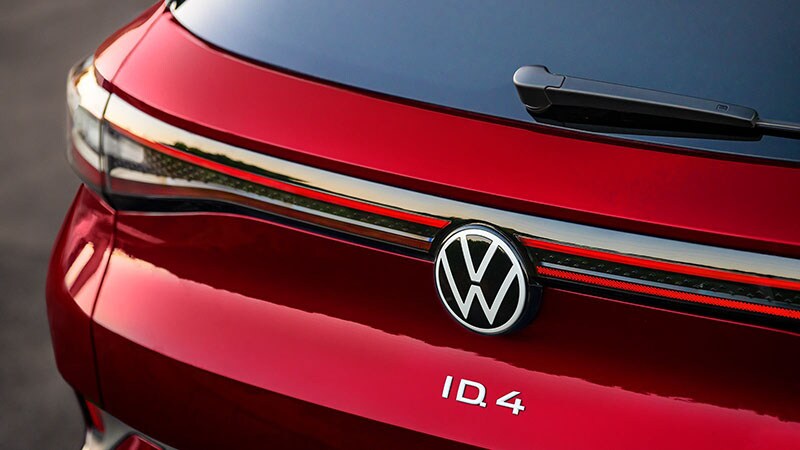
What you want in your electric warranty
The heart of the electric vehicle (EV) is the battery, so the biggest thing you’ll want to look for in your EV warranty is battery coverage. The Volkswagen ID.4 has an 8-year/100,000-mile (whichever occurs first) warranty specific to the High Voltage Battery8. Additionally, all your other warranty benefits are covered in Carefree Coverage9, which come standard on all MY21 vehicles. The ID.4 has a 4-year/50,000-mile (whichever occurs first) New Vehicle Limited Warranty10. Plus, you’ll get 2-year/20,000-mile Scheduled Carefree Maintenance11 and with 3-year/36,000-mile Roadside Assistance12, your out-of-charge vehicle can be towed to the nearest Electrify America station free of charge. There is no limit to the number of times you can use this service per year, and it’s available 24/7. We have all these warranties and services in place, because we believe being confident in your Volkswagen is everything. You can find all the warranty details on the ID.4 model page.
Disclosures
1. 2024 ID.4 Pro EPA estimated total range is 291 miles. Actual mileage and range will vary and depend on several factors including driving and charging habits, accessory use, temperature and topography, battery age, load, and vehicle condition. Battery capacity decreases with time and use. See owner’s manual for details.
2. Actual mileage and range will vary and depend on several factors including driving and charging habits, accessory use, temperature and topography, battery age, load, and vehicle condition. Battery capacity decreases with time and use. See owner’s manual for details.
3. The 2024 ID.4 Charging Plan is included with new model year 2024 Volkswagen ID.4 vehicles purchased from an authorized U.S.-based Volkswagen dealer. Thirty-six (36) months of Pass+ membership and 500 kWh of complimentary DC Fast and L2 charging begins upon vehicle purchase. Complimentary charging does not include any idle fees and their associated or applicable taxes assessed at the charging station. You will be responsible for paying such fees through your account if you incur them during a charging session. Non-transferable. Not available for commercial use, such as ride-hailing and ridesharing. Requires Electrify America account, app, acceptance of Terms of Use, Privacy Policy, Promotion Terms and Conditions, enrollment in 2024 VW ID.4 Charging Plan, and $10 deposit to pre-fund idle fees, which may be automatically reloaded. See Terms of Use for details. Unused idle fee deposit will be refunded when account is closed. After the 2024 ID.4 Charging Plan benefits terminate or expire, your account will convert to a basic Electrify America “Pass” account. Plug&Charge can only be used at Electrify America DC fast charging and Level 2 public charging stations. The feature is available for use upon purchase of a new, unused 2023 or 2024 ID.4 EV and can only be utilized by the original purchaser/owner for the duration of the included charging plan. Not valid for subsequent owners. Functionality will deactivate upon expiration of the included 3-year charging plan, which begins upon vehicle purchase. Requires Electrify America mobile app, account, enrollment in the included ID.4 charging plan, acceptance of Plan Disclosure, set up of payment method and activation of Plug&Charge in the Electrify America app. Activation usually takes a few minutes but may take longer depending on your vehicle and its cellular connectivity.
4. Carefree Coverage available on all new MY24 ID.4 vehicles. Carefree Maintenance provides 10,000- and 20,000-mile scheduled maintenance services or scheduled maintenance services for two years (whichever occurs first) as stated in the vehicle’s maintenance booklet. Does not include tire rotations, or other services or parts not specified in the owner’s literature. 3 years/36,000 miles (whichever occurs first) Roadside Assistance provided by a third party. 4 years/50,000 miles (whichever occurs first) New Vehicle Limited Warranty. 8 year/100,000 miles (whichever occurs first) high-voltage battery limited warranty. Battery capacity decreases with time and use. Warranty coverage may not return battery capacity to an “as new” condition with 100% net capacity. See owner’s literature or dealer for warranty, maintenance program, and roadside assistance details, exclusions, and limitations. Car-Net Remote Access services require cellular connectivity, GPS signal, and acceptance of Terms of Service. Not all services and features are available on all vehicles. Other Car-Net services require a trial or paid subscription. See additional important information carnet.vw.com.
5. 3 years/36,000 miles (whichever occurs first) Roadside Assistance on all new MY24 vehicles provided by a third party. May require additional payment for services rendered. For vehicle eligibility details, visit vw.com/coverage. See owner’s literature or dealer for limitations and details.
6. Based on an 11kW Level 2 charger for 7.5 hours, and a 7.2kW Level 2 charger for 11.5 hours. Charging times will vary and depend on a variety of factors, including ambient temperature, charger type, battery condition and initial state of charge, vehicle condition and others.
7. Claim based on driving 15,000 miles per year for 5 years, using EPA efficiency estimates for ID.4 and EPA assumptions for MY24 vehicles of $3.66 per gallon of gasoline, 0.14 kW-hr for electric charging and an average gasoline vehicle fuel economy of 28 MPG Combined City/Highway. Assumes home charging of ID.4. Actual savings, if any, will vary and depend on several factors including location, driving and charging habits, fuel price fluctuations, temperature and topography, accessory use, battery age, load, and vehicle condition.
8. 8 year/100K miles (whichever occurs first) High-Voltage Battery Limited Warranty coverage on MY24 ID.4 electric vehicles. Battery capacity decreases with time and use. Limited warranty coverage may not return battery capacity to an “as new” condition with 100% net capacity. See owner’s literature or dealer for limited warranty details.
9. Available on most new MY24 vehicles. For vehicle eligibility details, visit vw.com/coverage. VW’s Carefree Maintenance Program provides 10,000- and 20,000-mile scheduled maintenance services or scheduled maintenance services for two years (whichever occurs first) as stated in the vehicle’s maintenance booklet. Does not include tire rotations, or other services or parts not specified in the owner’s literature. 3 years/36,000 miles (whichever occurs first) Roadside Assistance provided by a third party. 4 years/50,000 miles (whichever occurs first) New Vehicle Limited Warranty. See owner’s literature or dealer for warranty, maintenance program, and roadside assistance details, exclusions, and limitations. Car-Net Remote Access services require cellular connectivity, GPS signal, and acceptance of Terms of Service (services not available on MY20 Passat). Not all services and features are available on all vehicles. Other Car-Net services require a trial or paid subscription. See additional important information at www.vw.com/carnet.
10. 4 years/50,000 miles (whichever occurs first) New Vehicle Limited Warranty on most new MY24 VW vehicles. For vehicle eligibility details, visit vw.com/coverage. See owner’s literature or dealer for warranty exclusions and limitations.
11. VW’s Carefree Maintenance program provides the 10,000- and 20,000-mile scheduled maintenance services or scheduled maintenance services for two years (whichever occurs first) as stated in the vehicle’s maintenance booklet on most new MY24 VW vehicles. For vehicle eligibility details, visit https://vw.com/en/carefree-coverage. See dealer or owner’s literature for provided services, exclusions, and time and other limitations. The Carefree Maintenance program does not provide tire rotations, or other services or parts not specified in the owner’s literature.
12. 3 years/36,000 miles (whichever occurs first) Roadside Assistance on most new MY24 VW vehicles provided by a third party. For vehicle eligibility details, visit vw.com/coverage. See owner’s literature or dealer for limitations and details.